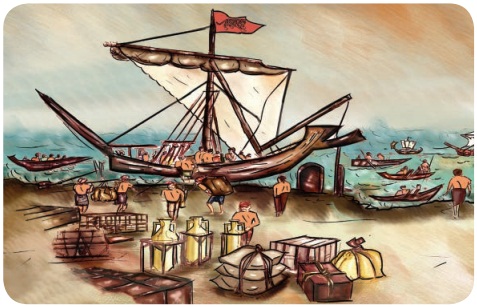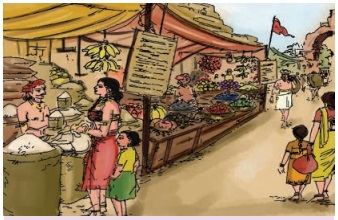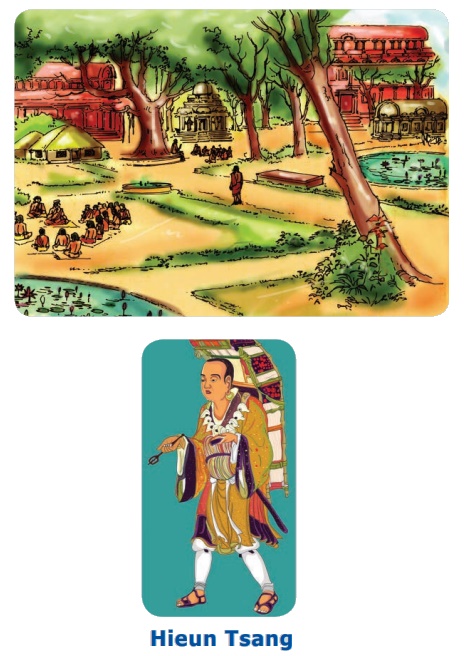Term 1 Unit 4 | History | 6th Social Science - Ancient Cities of Tamilagam | 6th Social Science : History : Term 1 Unit 4 : Ancient Cities of Tamilagam
Chapter: 6th Social Science : History : Term 1 Unit 4 : Ancient Cities of Tamilagam
Ancient Cities of Tamilagam
Unit 4
Ancient Cities of Tamilagam

Learning Objectives
* To learn
about the greatness of the towns of ancient Tamilagam.
* To know
about Poompuhar, Madurai and Kanchi.
* To understand
the ancient kingdoms of Tamilagam.
* To gain
knowledge about the crafts, markets, manufactures, maritime trade, education and
water management in ancient Tamilagam.

[It is a Government Higher Secondary School.
Reciprocating the greetings of the students of VI Std, the Social Science Teacher
signals them to get seated]
Teacher: Wow! You look pretty in your new dress, Tamilini.
Students: Ma’m, today is her birthday.
Teacher: Wish you a happy birthday Tamilini. Many
more happy returns of the day.
Students: How come ma’m? What is the connection between
Tamilini’s birthday and today’s class?
Teacher: There is. I shall come to that later. Let
us stand up and wish her first.
Students: Happy birthday, Tamil.
Tamilini: Thank you all.
Teacher: Tamil, Is Chennai your home town?
Tamilini: No ma’m. My home town is Kadavur near Karur.
Teacher: Good. Do you have the habit of visiting your
home town?
Tamilini: Yes ma’m. Every summer I visit my home town.
Teacher: Excellent! Can you tell me the difference
between Kadavur and Chennai?
Tamilini: Kadavur is a village. Chennai is a city.
Teacher: Excellent!
Teacher: Can you tell what were the earliest planned
cities of ancient India?
Students: Harappa and Mohenjo-Daro, ma’m.
Teacher: Yes. Very good children. Today we are going
to study about the ancient towns of Tamilagam. They are Poompuhar, Madurai, Kanchi.
Shall we start?
Students: Ok
ma’m.
Teacher: See we have started today’s lesson with Tamilini’s
birthday.
Students: Yes mam.
Mesopotamian
civilisation is the earliest civilisation in the world. It is 6500 years old.
Teacher: Like Harappa and Mohenjo-Daro in ancient India,
there were famous towns in ancient Tamilagam too. Madurai, Kanchi and Poompuhar
are prominent among them.
Tamil literature, accounts
of foreign travellers and archaeological finds provide us information about the
ancient towns of Tamilagam.
Poompuhar
Poompuhar is one of
the oldest towns in ancient Tamilagam. This is the place where well known characters
of Silapathikaram, Kovalan and Kannagi lived. It was also a port town along the
Bay of Bengal. The ports were established for facilitating maritime trade. Even
in times past, countries began to export their surplus products and import the scarce
commodities by sea. Poompuhar is one such historic port that emerged in the wake
of increasing maritime trade. It is a coastal town near the present-day Mayiladuthurai
and is located where the river Cauvery drains into the sea.
Poompuhar Port
Poompuhar was also known
by names such as Puhar and Kaveripoompattinam. It served as the port of the early
Chola kingdom. One of the popular Sangam Literature. Pattinappaalai and Tamil epics, Silappathikaram and Manimegalai, have
references to the brisk sea-borne trade that took place in the port city, Puhar.
Silappathikaram, in particular, speaks about the greatness
of Poompuhar. The lead female character of Silappathikaram
is Kannagi.

Her father is
Maanaigan. Sea traders are known by the name Maanaigan. The male character Kovalan’s
father is Maasathuvan. Massathuvan means a big trader. It is clear from the text
that Poompuhar was a place where big traders and sea traders had settled down.
Numerous merchants from
foreign countries such as Greece and Rome landed at Poompuhar. Due to busy and continuous
trade, many of them stayed on indefinitely in Poompuhar. There are evidences of
foreigner settlements in the town. People speaking many languages inhabited Poompuhar
in its glorious days. As loading and unloading of ships took some months, the foreign
traders began to interact with the local people during that period. This enabled
the natives to learn foreign languages for communication. Similarly, the foreigners
also learnt Tamil to communicate with the natives. This contact facilitated not
only exchange of goods but also languages and ideas resulting in cultural blending.
The traders of Poompuhar
were known for their honesty and integrity. They sold goods at legitimate prices.
Pattinappaalai states that “selling
any commodity at a higher price was considered bad”.
The author of Pattinappaalai, Kadiyalur Uruttirangannanar,
belonged to 2nd century BCE. This is indicative of Puhar’s antiquity. Horses were
imported by sea. Pepper was procured through the land route. Gold that came from
Vadamalai was polished and exported to the overseas countries. Sandal from Western
Ghats, pearls from southern sea, corals from eastern sea and food items from Eelam
were imported.
Poompuhar had been built
differently from other towns. Each social group had a separate settlement. Streets
were broad and straight, dotted with well-designed houses. There was also a dockyard.
We can learn about the
life of the people of Puhar by reading Pattinappaalai and “Puhar Kandam” of Silappathikaram.
Puhar was a busy port
upto 200 CE. It might have been either washed away by sea or destroyed by big shore
waves. The remains of that destruction can still be seen in the present Poompuhar
town.
Madurai
Madurai has been one
of the oldest cities in India. Its antiquity can be understood from the sobriquet
“Sangam Valartha Nagaram” it has earned.
Pandyas, the Cholas
and later the Kalabras ruled Madurai in the ancient period. During medieval times,
later Cholas and later Pandyas followed by the Nayaks ruled this historic town.
This has resulted in cultural blending. Trade flourished and evidence for this has
been unearthed in archaeological excavation done in Keezhadi near Madurai.
Madurai is proudly associated
with tamil sangam (academies), which worked for the promotion of Tamil language.
Forty-nine poets were associated with the last Sangam.
Thoonga Nagaram

Madurai
had Naalangadi and Allangadi.
Naalangadi – Day Market.
Allangadi
– Evening Market
Madurai
is known as Thoonga Nagaram (the city that never sleeps). Madurai was a safe place
where women purchased things from Allangadi without any fear.

Ahil, fragrant wood,
was brought from Port Thondi to Madurai. King Solomon of ancient Israel imported
pearls from Uvari near the Pandyan port, Korkai.
A mint of Roman coins
was present at Madurai. The coins of other countries were also minted at Madurai,
which is a proof for the glory of Madurai.
The fame of Madurai
is attested by the accounts of the Greek historian Megasthanese. Chanakya, Chandragupta’s
minister, makes a mention of Madurai in his book, Arthasastra.
In the moat around the
town, tunnels had been constructed in such a way that even elephants could comfortably
enter.
Kanchi
A place of learning
is called school. Several schools were established in great numbers for the first
time in Kancheepuram. Jains studied in Jainapalli,
and Buddhists studied in Viharas.
The greatness of Kanchi
as an educational centre can be understood from the fact that the Chinese traveller
Hieun Tsang who studied at Nalanda University visited Kanchi ‘Kadigai’ to
pursue his further studies.

Poet Kalidasa says,
“Kanchi is the best of the towns”. Tamil poet saint Thirunavukarasar praises Kanchi
as “Kalviyil Karaiillatha Kanchi”.
Hieun Tsang remarked
that Kanchi can be counted as one among the seven sacred places like Budh Gaya and
Sanchi. Kanchi is the oldest town in Thondai Nadu. Scholars like Dharmabalar, Jothibalar,
Sumathi and Bodhi Dharmar were born in Kanchi.
Kanchii also known as
the templetown. The famous temple of great architectural beauty, Kailasanathar temple,
was built by later Pallava king Rajasimha at Kanchi. During the Pallava period,
a large number of cave temples were built. The Buddhist monk Manimegalai spent the
last part of her life at Kanchi speaks highly of that town.
Water management played
an important role in the agrarian society of those times. Hundreds of lakes were
created for storing water around the town of Kanchi. These lakes were well connected
with canals. During the later period, Kanchi came to be known as the district of
lakes. Water management skills of the ancient Tamils can be understood from the
construction of Kallanai in the Chola country and the lakes and canals in Kanchi.
Apart from Poompuhar,
Madurai and Kanchi, there were other towns too in ancient Tamilagam. Korkai, Vanchi,
Thondi, Uraiyur, Musiri, Karuvur, Mamallapuram, Thanjai, Thagadoor and Kaayal are
some of them. By conducting archaeological research, more information can be gathered
about these places.
Thank you students.
With this, we shall complete this lesson now.
Poompuhar was a port.
Madurai was a trading town. Kanchi was an educational centre.
Tamil sayings represent
the uniqueness of each ancient Tamil kingdom
Chola Nadu - sorudaithu
(rice in abundance).
Pandya Nadu - muthudaithu
(pearls in abundance).
Chera Nadu - vezhamudaithu
(elephants in abundance).
Thondai Nadu - Saandrorudaithu
(scholars in abundance)
Chera Nadu - Comprised Malayalam-speaking regions
and Tamil districts of Coimbatore, Nilgiris, Karur, Kanniyakumari and Some parts
of present Kerala.
Chola Nadu - Present-day Thanjavur, Tiruvarur,
Nagai, Trichy and Pudukkottai districts.
Pandya Nadu - Erstwhile composite Madurai, Ramanathapuram,
Sivagangai, Thuthukkudi and Tirunelveli districts
Thondai Nadu - Present-day Kancheepuram, Dharmapuri,
Tiruvallur, Tiruvannamalai, Vellore and northern parts of Villupuram districts.
Summary
* Madurai, Kanchi and Poompuhar are famous towns in
ancient Tamilagam.
* We know about the life of the people of Poompuhar
by reading Silappathikaram and Pattinappaalai.
* Madurai is associated with three sangams.
* Kanchi was an educational centre. Many great scholars
were associated with it.
* Kanchi known as a city of temples, was also known
for water management.
GLOSSARY
1. Maritime Trade - trade by sea
2. Foreigner - a person who comes from another country
3. Blending - the mixings
4. Integrity - the quality of being honest
5. Legitimate - reasonable prices prices
6. Antiquity - a long time ago
7. Sobriquet - nick name
8. Mint -
A place where coins are made
9. Moat -
a deep and wide trench filled with water surrounding a palace
Related Topics